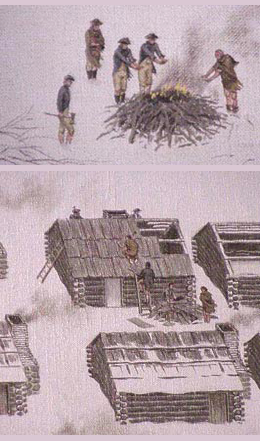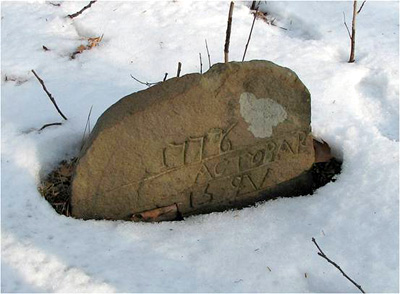
Replicas of the Revolutionary War huts that troops lived in in Morristown, NJ, during the severe winter of 1779-80.
Even with the upper atmospheric Polar Vortex bearing down on the Hudson Valley this year, the winter of 1779 was one for the record books. Forget Valley Forge in 1777-1778. Many historians consider the winter when General George Washington’s troops camped at Morristown, NJ, in 1779-1780 to be the most severe winter of the 18th century.

Scenes from the Morristown National Historical Park Visitor Center mural / Morristown National Historical Park
Curator of Harmony Hall Geoff Welch will explore the local historical significance of the Revolutionary troops stay around what would become Sloatsburg Monday evening at the Sloatsburg Library. Welch’s discussion and slideshow offering will cover the The Severe Winter of 1779-80 and the Revolutionary War in the Ramapo Pass, and begins at 7 p.m. in the library’s community room.
Washington’s Continental Army was spread out through the highlands and Ramapough Pass as late fall turned into an early winter in 1779. Welch said that Revolutionary War troops camped throughout this area during that winter, which saw ice storms, blizzards and rivers freeze over.
“There were 26 snow storms that winter,” Welch said. “Washington had decided that the army would winter over at Morristown, NJ, but there were a lot of troops in the highlands and the Ramapough Pass. Some of the troops didn’t make it out of the mountains and died of exposure.”
Sloatsburg’s Original Watering Hole
Welch also explores bits of early Sloatsburg history. Before Stephan Sloat up and married Martha Van Dusen and built the Sloat House & Inn, there was the Van Dusen Tavern. Built by Issac Van Dusen around 1714, the remains of the old house and tavern can still be seen off of Rt. 17 just south of Auntie Els. Samual Sidman also married a Van Dusen and took over the old tavern around 1748. Sidman’s Tavern became the local headquarters for Continental army officers in the Ramapough Pass throughout the Revolutionary War, as well as during the winter of 1779-80. Washington met often with officers there.
Sidman’s Tavern is now known as the Smith House and is in the process of being transferred to the Town of Ramapo as an historical site.
The Smith House borders the Old Clove Road (parts of which were at onetime Rt. 17), which itself borders the Revolutionary War cemetery that is the final resting place for many of the soldiers who died in these parts. The entire area is now the proposed site of a 384 unit apartment development on 54 acres tentatively called Woodmont Hills.
Geoff Welch’s historical converseration The Severe Winter of 1779-80 and the Revolutionary War in the Ramapo Pass, takes place Monday, February 24, at the Sloatsburg Library at 7 p.m. in the library’s community room. For more information, call 845.753.2001.



